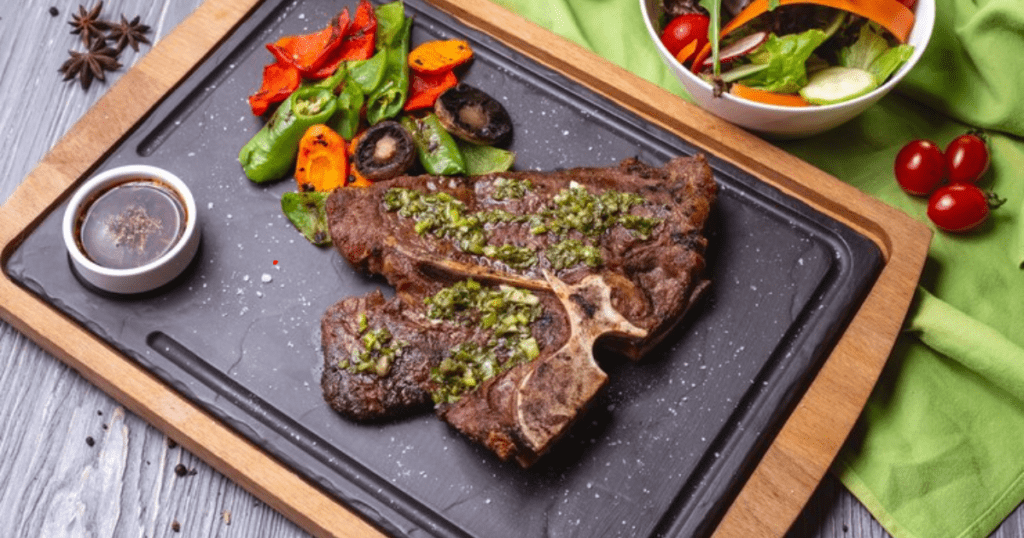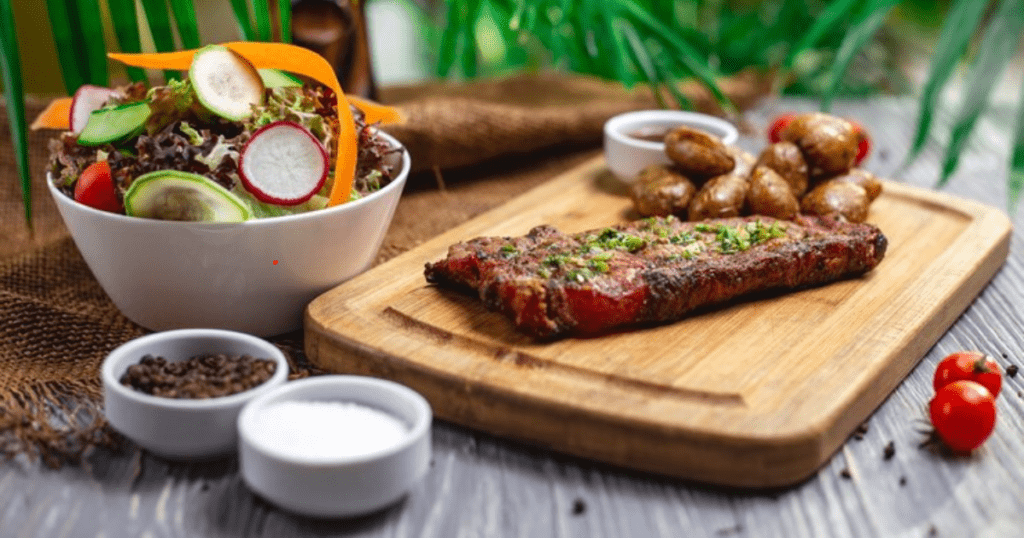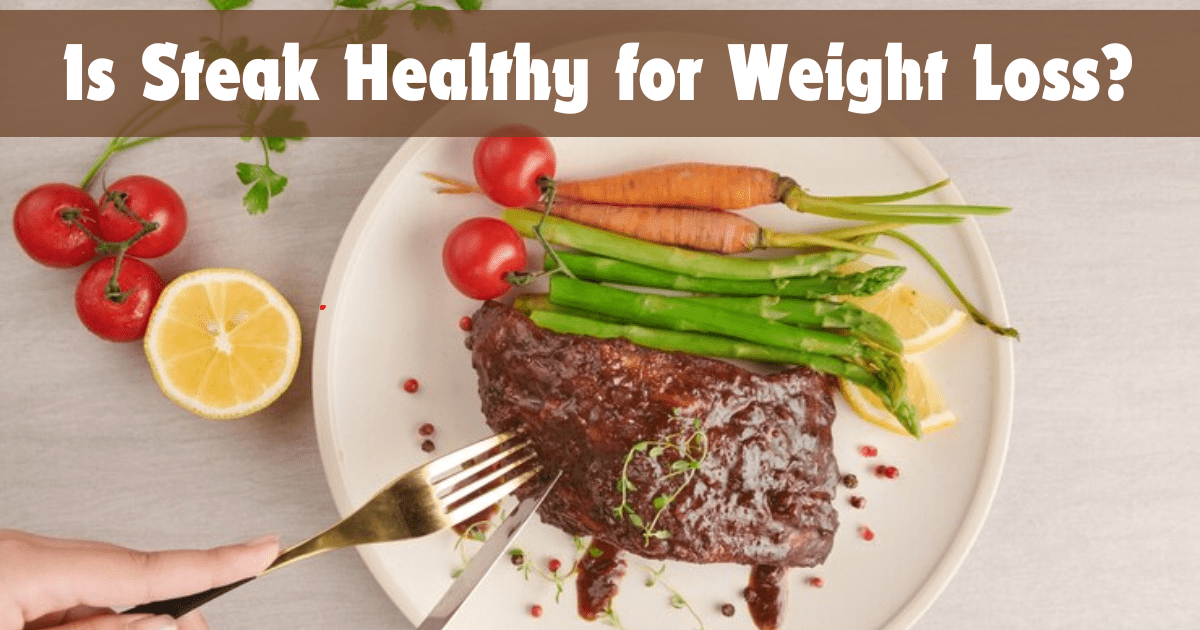When you want to lose weight, picking the right foods is super important. Many people like steak, but they wonder if it’s healthy for weight loss. Is it helpful or not? Let’s look at what steak has in it, why it might be good for you, and any reasons it might not be, to see if it can fit into a healthy plan for losing weight.
Nutritional Profile of Steak
The nutritional profile of steak can vary depending on the cut and preparation method, but here is a general overview of the nutrients found in a typical 3.5-ounce (100 grams) serving of cooked beef steak:
Macronutrients:
- Calories: Approximately 250-300 kcal
- Protein: 25-30 grams
- Fat: 15-20 grams
- Saturated Fat: 6-8 grams
- Monounsaturated Fat: 6-8 grams
- Polyunsaturated Fat: 0.5-1 gram
- Carbohydrates: 0 grams
- Fiber: 0 grams
- Sugars: 0 grams
Micronutrients:
- Iron: 2.6-3.0 mg (14-17% of the Daily Value, DV)
- Zinc: 4.5-5.0 mg (40-45% of DV)
- Selenium: 25-30 mcg (45-55% of DV)
- Vitamin B12: 2.5-3.0 mcg (100-125% of DV)
- Niacin (Vitamin B3): 7-8 mg (45-50% of DV)
- Phosphorus: 200-220 mg (20-22% of DV)
- Vitamin B6: 0.4-0.5 mg (20-25% of DV)
- Riboflavin (Vitamin B2): 0.2-0.3 mg (15-20% of DV)
Other Nutrients:
- Cholesterol: Approximately 70-90 mg
- Creatine: Present in significant amounts, beneficial for muscle energy.
- Carnosine: An antioxidant that helps with muscle endurance.
Is Steak Healthy for Weight Loss?
Steak is a high-protein, low-carbohydrate food that is rich in essential nutrients like iron, zinc, and B vitamins. It is suitable for weight loss due to its low carbohydrate content.
To lose weight, choose lean cuts like sirloin, tenderloin, or flank steak, which have less fat. Cook steak using grilling, broiling, or baking methods, and avoid adding excessive butter or oil. Incorporate steak into a balanced diet with vegetables, whole grains, and healthy fats.
However, some cuts may be high in saturated fat, increasing the risk of heart disease. Steak is calorie-dense, so be mindful of portion sizes. Overall, steak can be a healthy weight loss food when consumed in moderation.

How Can Steak Be Healthy for Weight Loss?
Steak, when consumed in moderation and as part of a balanced diet, can be healthy for weight loss due to several factors:
1. High Protein Content
Steak is high in protein, which is needed for muscle growth and repair. Protein is also highly satiating, which means it might keep you fuller for longer, lowering your overall calorie intake.
2. Thermogenic Effect of Protein
Protein digestion requires more energy than fat or carbohydrates. This mechanism, known as the thermic effect of food (TEF), can increase your metabolism and help you burn calories.
3. Nutrient Density
Steak contains critical elements such as iron, zinc, and B vitamins, which are beneficial to overall health and can improve energy levels and metabolism. These nutrients can help you stay physically active and burn more calories.
4. Supports Muscle Maintenance
Maintaining muscle mass is important for weight loss because muscles burn more calories at rest than fat. The protein in steak helps to maintain muscular mass, especially when combined with regular exercise.
5. Low in Carbohydrates
Steak is naturally low in carbohydrates, making it an ideal choice for low-carb and ketogenic diets, which can aid in weight loss for some people.

Side Effects of Eating Too Much Steak
Eating too much steak can have a number of detrimental impacts on health. Here are some possible issues:
- Heart Disease: Consuming a lot of red meat, including steak, increases your risk of developing heart disease. This is due to steak’s high quantities of saturated fat and cholesterol, which can cause plaque buildup in the arteries.
- Cancer chance: According to some research, eating a lot of red meat, especially processed red meat, may raise your chance of developing some cancers, such as colorectal. This could be related to substances produced during high-temperature cooking, such as grilling or barbecue.
- Weight Gain: Steak is high in calories, thus eating it in big quantities might lead to weight gain. Excessive calorie intake without adequate physical activity might result in obesity and other health concerns.
- Kidney Problems: A high-protein diet, particularly from animal sources, might place a burden on your kidneys. This is especially concerning for people who have preexisting kidney issues.
- Gout: Steak is heavy in purines, which can cause excessive amounts of uric acid in the blood. High uric acid levels can cause gout, a type of arthritis characterized by intense joint pain, redness, and swelling.
- Digestive Problems: Eating too much red meat might cause constipation and bloating. Meat-based diets frequently lack dietary fiber, which contributes to this phenomenon.
- Type 2 Diabetes: Some research has connected a high intake of red meat to an increased risk of acquiring type 2 diabetes. This could be due to the iron level in red meat, which can alter insulin sensitivity.
- Inflammation: Consuming a lot of red meat can cause chronic inflammation in the body, which has been linked to a variety of chronic ailments, including heart disease, diabetes, and cancer.
- Iron Overload: Consuming an excessive amount of red meat can result in iron overload, particularly in people with hemochromatosis. This can cause harm to organs including the liver and heart.
How Much Steak Can You Eat?
The amount of steak a person can eat varies greatly depending on several factors, including individual appetite, metabolism, dietary preferences, and overall health.
General Guidelines
- Appetite and Preference: Some people may be satisfied with a small portion, such as 4-6 ounces, while others might enjoy a larger serving of 12-16 ounces or more.
- Health Considerations: Moderation is key. Consuming large amounts of red meat regularly can have health implications, such as increased risk of heart disease and certain cancers.
- Dietary Balance: It’s important to balance steak with other food groups. A well-rounded meal should include vegetables, grains, and other protein sources.
- Event Context: The context of eating (e.g., a special occasion, competitive eating event, or a regular meal) can influence how much steak is consumed.
Recommendations
- Standard Serving Size: For a typical meal, a serving size of steak is usually around 3-4 ounces for women and 4-6 ounces for men.
- Occasional Indulgence: On special occasions, larger portions are common, but it’s advisable to keep it within reasonable limits to avoid discomfort and potential health issues.
- Competitive Eating: In competitive eating scenarios, individuals can consume significantly larger quantities, but this is not recommended for regular practice due to health risks.

Conclusion
Steak can be a healthy component of a weight loss diet when consumed in moderation and in conjunction with other nutrient-dense foods. Its high protein content, necessary minerals, and ability to increase satiety make it an excellent supplement to any weight loss strategy. However, portion management and careful selection of lean cuts are essential for reaping the advantages without overeating calories or bad fats.
People Also Ask
1. Can I Eat Steak If I Want to Lose Weight?
Yes, you can eat steak and lose weight! Steak is high in protein, which helps you feel full while also building muscle. To avoid excess fat, limit your portion sizes and choose for lean cuts such as sirloin or tenderloin.
2. What’s the Best Way to Cook Steak for Weight Loss?
Yes, you can eat steak and lose weight! Steak is high in protein, which helps you feel full while also building muscle. To avoid excess fat, limit your portion sizes and choose for lean cuts such as sirloin or tenderloin.
3. Is Steak More Healthy Than Chicken for Weight Loss?
Both steak and chicken can be beneficial for weight loss. Chicken is usually leaner, meaning it has less fat, however steak contains more iron, which is beneficial to your blood. It is acceptable to have both as part of a balanced diet. Just make sure to limit your portion sizes and choose lean cuts.
4. How Often Can I Eat Steak When Trying to Lose Weight?
It’s fine to eat steak a few times per week as long as you balance it with other nutritious foods. Too much red meat can be unhealthy, so balance it with other proteins such as chicken, fish, beans, and tofu.
5. What Should I Eat With Steak to Help Lose Weight?
Pair your steak with a variety of veggies, such as broccoli, spinach, or salad. These are low in calories yet high in nutrients, so you’ll stay full and happy. Avoid high-calorie side dishes such as creamy mashed potatoes and cheesy spaghetti.









Leave a Reply